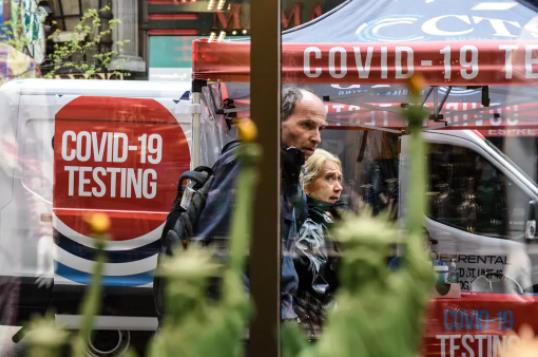
 i_need_contribute
i_need_contribute

Walking past a coronavirus mobile testing site in Manhattan, on Monday.Credit...Stephanie Keith for The New York Times
The coronavirus is constantly mutating. While some variants seem to vanish, causing little ripples of surges in their wake, others have kept driving large outbreaks. Experts say a new form, BA.2.12.1, is spreading rapidly and will probably become the dominant form of the virus in the United States in the next few weeks. There’s no indication yet that it causes more severe disease than earlier forms did.
In the week endied Saturday, BA.2.12.1 made up about 36 percent of all new cases in the United States, according to estimates by the Centers for Disease Control and Prevention. That’s up from 26 percent of cases in the prior week, and 16 percent of infections during the second week in April.
(The latest figures are rough estimates, subject to revision as more data come in. Genetic sequencing of the virus is performed on just a portion of test samples across the country.)
First detected in the United States by New York State health officials in April, BA.2.12.1 is spreading more rapidly than the first versions of the Omicron variant, which caused a huge surge in cases over the winter. The new version descends from BA.2 and appears to have spread even more quickly than BA.2, although the reasons are still under investigation.
Indeed, the virus seems to keep finding ways to spread more easily. “Omicron was more transmissible than Delta, which was more transmissible than Alpha,” Krista Queen, director of viral genomics and surveillance at Louisiana State University, said in an interview on Wednesday. BA2.12.1 is building on that trend, she added, “and that’s why it’s taking over now, especially in the Northeast.”
New cases in New York have increased, though they remain far below the horrific numbers seen earlier in the pandemic. A number of counties have become hot spots, reminding state health officials that the coronavirus will not surrender, regardless of general pandemic fatigue.
Dr. Queen, who oversees genetic analysis of the virus at the university, said she expects rising infections to spread from the Northeast to the South and then the West, driving more outbreaks. “We’re already seeing it here in Louisiana,” she said. “Our most recent sequencing runs of community samples have all been BA.2.12.1, and those samples are from mid-April.”
Reports of new cases nationally have doubled in the past month as Omicron subvariants have spread, according to a New York Times database. In the last two weeks, the daily average number of new cases overall has risen by 50 percent.
Reported cases are probably an undercount of the virus’s true spread, since access to at-home tests has increased and the results are often not officially reported.
Virtually every reported new infection across the nation now involves an Omicron subvariant, and although BA.2 is still the dominant form, BA.2.12.1 is quickly gaining ground.
Dr. Rochelle Walensky, the director of the Centers for Disease Control and Prevention, said last week that the agency was beginning to focus on BA.2.12.1 in addition to BA.2.
“Epidemiologically, it doesn’t appear as if we’re seeing more severe disease in places that are having more cases,” she said. “So we are not anticipating more severe disease from some of these subvariants, but we are actively studying it.”
Hospitalizations have risen more slowly than new cases, and are up 18 percent in the last two weeks, but trends in hospitalizations tend to trail those in new cases. Deaths have decreased 17 percent nationally in the last two weeks; those statistics tend to lag even farther behind.
Early research suggests that BA.2.12.1 evades the body’s immune defenses more adroitly than previous versions of the coronavirus, and that characteristic seems to account in some measure for its rapid spread. “In two weeks, it will probably be everywhere,” said Massimo Caputi, a professor of biomedical science at Florida Atlantic University.
But the subvariant is also finding more opportunities because of behavior changes. Taj Azarian, a genomic epidemiologist at the University of Central Florida, said he believes the recent surge is mostly due to “the great unmasking.”
“We’re in this phase of pandemic fatigue and complacency,” he said. “And while we need to balance the weight of mental health with the risk of contraction, as a result we’ve seen an uptick not only in the Omicron variant but other respiratory illness.”